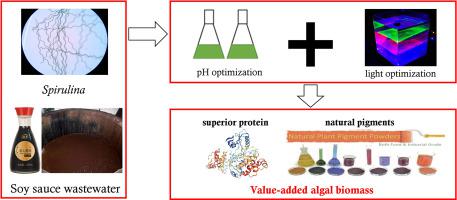Algal Research ( IF 4.6 ) Pub Date : 2020-12-13 , DOI: 10.1016/j.algal.2020.102157 Pei Han , Qian Lu , Huiqi Zhong , Jiawen Xie , Lijian Leng , Jingjing Li , Liangliang Fan , Jun Li , Paul Chen , Yuping Yan , Feng Wei , Wenguang Zhou

|
Soy sauce is one of the most common condiments in East Asian cuisines. Its manufacturing process generates a large amount of organic-rich soy sauce wastewater, which is difficult to treat through traditional processes. In this study, Spirulina NCU-Sm was used to treat soy sauce wastewater and simultaneously produce value-added biomass. The results showed that NCU-Sm grew well in 100% (undiluted) raw soy sauce wastewater (RSW). The maximum biomass yield of NCU-Sm reached 1.984 g/L, and the removal efficiencies of NH4+-N, TN, COD, chromaticity, and salinity in RSW reached 93.86, 81.76, 84.08, 40.93, and 63.08%, respectively. High COD removal efficiency in 100% RSW proved NCU-Sm grew in mixotrophic mode. pH and light spectrum, two major factors affecting growth of soy sauce wastewater-grown Spirulina NCU-Sm, were further studied. When the initial pH of RSW was adjusted to 8, NCU-Sm biomass yield was increased by 11.11%, and the contents of protein, chlorophyll-a, and carotenoid were increased by 8.69, 37.14, 40.40%, and reached 65.57%, 7.57 and 2.78 mg/g, respectively. The removal efficiencies of NH4+-N, TN, and chromaticity in RSW with pH 8 were improved to 99.34, 88.29, 43.18%, respectively. Red light enhanced the photosynthetic oxygen release efficiency of NCU-Sm and increased the carotenoid content of NCU-Sm by 117.95%, reaching 5.95 mg/g. Blue light was adverse to the growth and reduced the protein content of NCU-Sm but significantly increased its chlorophyll-a content to up to 10.99 mg/g. These results suggest that cultivation of Spirulina in soy sauce wastewater serves dual roles in soy sauce wastewater treatment, as well as value-added algal biomass (such as high-quality protein and natural pigments raw materials) production.
中文翻译:

从酱油废水中回收养分,以培养最大的螺旋藻
酱油是东亚美食中最常见的调味品之一。其制造过程会产生大量富含有机物的酱油废水,而这些废水很难通过传统方法进行处理。在这项研究中,螺旋藻NCU-Sm用于处理酱油废水并同时生产增值生物质。结果表明,NCU-Sm在100%(未稀释)的生酱油废水(RSW)中生长良好。NCU-Sm的最大生物量产量达到1.984 g / L,NH 4 +的去除效率RSW中的-N,TN,COD,色度和盐度分别达到93.86、81.76、84.08、40.93和63.08%。100%RSW中的高COD去除效率证明NCU-Sm以混合营养模式生长。研究了影响酱油废水生长的螺旋藻NCU-Sm生长的两个主要因素的pH和光谱。将RSW的初始pH调整为8时,NCU-Sm生物量产率提高了11.11%,蛋白质,叶绿素-a和类胡萝卜素的含量分别提高了8.69、37.14、40.40%,达到了65.57%,7.57和2.78 mg / g。NH 4 +的去除效率pH为8的RSW中的-N,TN和色度分别提高到99.34、88.29、43.18%。红光增强了NCU-Sm的光合氧气释放效率,并使NCU-Sm的类胡萝卜素含量增加了117.95%,达到5.95 mg / g。蓝光不利于生长,降低了NCU-Sm的蛋白质含量,但显着提高了其叶绿素a含量,最高可达10.99 mg / g。这些结果表明,在酱油废水中种植螺旋藻在酱油废水处理以及增值藻类生物质(例如优质蛋白质和天然色素原料)生产中起着双重作用。











































 京公网安备 11010802027423号
京公网安备 11010802027423号